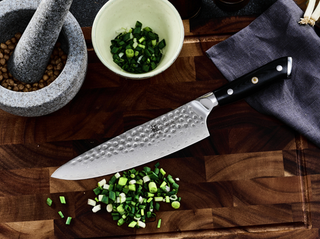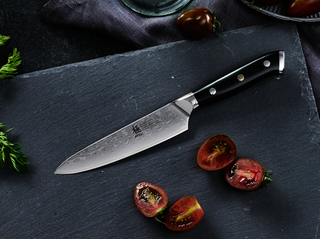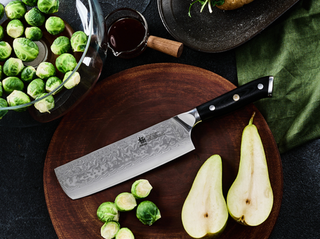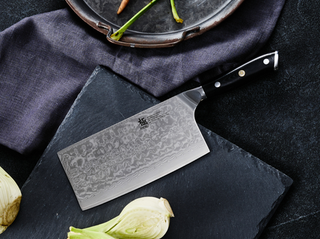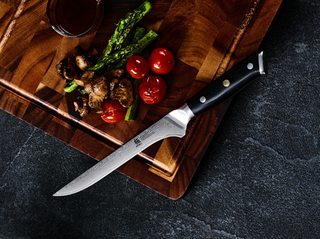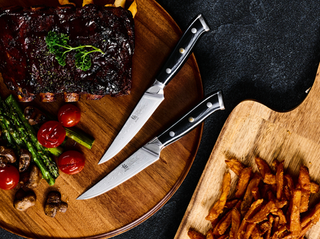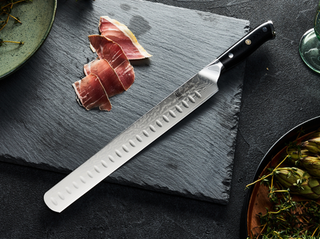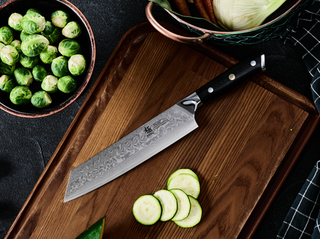That combination of chopped carrots, celery, and onion, which forms the base of so many recipes, is formally known as a mirepoix.
Mirepoix is one of the most important building blocks in cooking, and once you understand what it is, why it’s used, and how to make it properly, you’ll be able to take your home cooking to an entirely new level.
Well, you're in luck because we are breaking down exactly what mirepoix is, why it matters, how to prepare it, and even giving you some specifics on which Japanese knives will make your Mirepoix prep work a breeze.

What Exactly Is Mirepoix?
Mirepoix (pronounced meer-pwah) is a classic French flavor base made from onions, carrots, and celery. It is essentially these three vegetables cut (typically) into small, even pieces and slowly cooked to create a fragrant foundation for countless dishes.
The Classic Mirepoix Ratio
The standard ratio for cutting onions, carrots, and celery for mirepoix is 50%: 25%:25%
- 50% onion
- 25% carrot
- 25% celery
This ratio balances the sweetness, aroma, and earthy tones of the three vegetables without one overpowering the others.
Essential Mirepoix Ingredients: Why Each Matters
- Onions are the most essential ingredient for a mirepoix. They bring a natural sweetness and that signature savory onion aroma that fills your kitchen as soon as they hit the pan.
- The role of carrots in a mirepoix is to add subtle sweetness, color, and roundness to the flavor.
- Celery brings freshness, the herbal notes, and a slight bitterness that balances the carrots perfectly.
Individually, these three flavors are simple, but when put together in a mirepoix, they create the culinary equivalent of perfect background music: supportive, cohesive, and essential.
Why Does Mirepoix Matter So Much in Cooking?
Mirepoix isn’t meant to be the “star” of a dish, but it is an essential part of so many different dishes. A good mirepoix is the quiet backbone that gives soups, sauces, braises, and roasts their warmth and complexity.
When cooked slowly, the vegetables in the mirepoix soften, release their sugars, and blend into the dish seamlessly. Like with chicken noodle soup, you may not even notice they’re there, yet you’d absolutely notice if they were missing.
What Role Does Mirepoix Play in a Dish?
- Builds foundational flavor
- Adds sweetness without sugar
- Round, sharp, or acidic ingredients
- Enhances aroma
- Adds body and richness, especially in wet dishes
Popular Mirepoix Dishes
You’ll find mirepoix in countless recipes, but some of the most common mirepoix dishes are:
- Chicken noodle soup
- Beef stew
- Bolognese (French-style versions)
- Turkey gravy
- Stocks and broths
- Pot roast
- Chicken pot pie
- French sauces like velouté and demi-glace
In fact, if a recipe starts with “sauté onions, carrots, and celery,” you’re essentially making a mirepoix, even if the recipe does not explicitly call it a mirepoix

How to Make a Proper Mirepoix
The best thing about making a mirepoix is that you don’t need special ingredients or complicated techniques: all it takes is a good vegetable knife, the right mirepoix cut sizes for vegetables, and knowledge of the right mirepoix proportions into which to mix the ingredients.
1. Cut the Vegetables to the Right Size for Mirepoix
The classic mirepoix cut is ½-inch to 1-inch dice. This is the best size because it allows the vegetables to soften slowly without burning.
However, you can cut larger or slice thinner depending on the recipe you are making:
- For stock, you can cut the pieces larger.
- For sauces or long braises, use a finer dice.
- For delicate sauces or quick soups, you can even mince it slightly smaller.
When cutting vegetables for mirepoix, uniformity is key: as long as the pieces are even, they cook evenly.
2. Sweat, Don’t Brown
Mirepoix is meant to sweat, not caramelize. Heat a bit of butter or oil, add the vegetables, and cook over medium-low heat until they soften and turn fragrant.
At this stage of making a mirepoix, remember you are going for softness, sweetness, and aroma: not color.
3. Add Your Next Ingredients
Once the mirepoix is soft and translucent, you can add in meat, broth, tomatoes, herbs, or wine, depending on what you are making. From here, your dish starts to take shape.
Mirepoix vs. Soffritto: Why People Confuse Them
People often mix up mirepoix with soffritto, and it is quite easy to see why. Both involve slowly cooked aromatic vegetables, but they come from two different culinary traditions and serve different flavor goals.
- Both start with onions, carrots, and celery.
- Both are chopped aromatics.
- Both are used to build flavor.
Mirepoix vs. Soffrito: Key Differences
| Feature | Mirepoix | Soffritto |
| Cuisine Origin | French | Italian |
| Core Ingredients | Onion, carrot, celery | Onion, carrot, celery (often garlic or parsley added; some regions use bell pepper) |
| Fat Used | Butter or neutral oil | Olive oil (always) |
| Cut Size | ½-inch to 1-inch dice (varies by recipe) | Finer chop or mince |
| Cooking Method | Sweated gently without browning | Slowly cooked until fragrant, lightly golden, or even caramelized |
| Flavor Profile | Mild, sweet, subtle background flavor | Richer, more aromatic, more pronounced flavor |
| Common Uses | Stocks, soups, stews, sauces, gravies, braises | Pasta sauces (ragù, marinara), risotto, Italian stews, braises |
| Overall Purpose | Build neutral foundational flavor | Build a stronger, more robust flavor base |

Kyoku’s Best Japanese Knives for Cutting Mirepoix
A good knife makes mirepoix prep faster, safer, and much more enjoyable. Japanese knives, renowned for their precision and thin blades, excel in vegetable work.
Here are the best styles to use:
1. Gyuto (Japanese Chef’s Knife):
Japanese Gyuto knives are the best all-purpose knives, and they excel in almost any vegetable-cutting task. They are versatile and balanced, and great for both rocking and push-cutting.
For mirepoix cutting, consider Kyoku's 8" Gyuto Chef Knife. It is made of VG10 Damascus steel and an extra-wide and slightly curved blade that is perfect for slicing onions, carrots, and celery.
2. Nakiri: The vegetable specialist
If you want the easiest, cleanest vegetable cuts for your mirepoix, go for a Nakiri Knife. These knives feature straight blades, which make them ideal for chopping, and they are extremely efficient for uniform dicing.
This 7" Nakiri Knife is made of VG10 Damascus steel for hardness and durability, but its standout feature is its 7 x 1.9 in. (17.8x4.8 cm) straight, sharp blade that will cut cleanly through your vegetables without leaving any wedges or cracking your carrots.
3. Santoku: Great for beginners
If you want a knife that is shorter, lighter, and easy to control for cutting your veggies, a Santoku knife would be the perfect choice. They are excellent for small kitchens, they allow a lot of hand control, and they give you the most even, precise cuts.
If you want speed and consistency, the Nakiri is unbeatable. For versatility beyond mirepoix, the Gyuto is your long-term workhorse.
Final Thoughts
The good thing about mirepoix is that once you understand it (what it is, why it’s used, and how to prepare it), you start seeing it everywhere. It’s the quiet foundation behind your favorite soups, stews, gravies, and sauces.
And once you begin incorporating it intentionally into your cooking, you’ll notice your dishes develop deeper, richer, more balanced flavor.
You may also be interested in these 5 best ways to cut vegetables for different simple meals and recipes you may likely come across.
